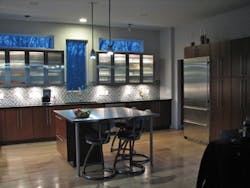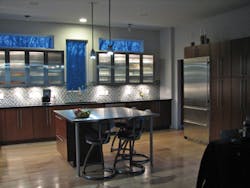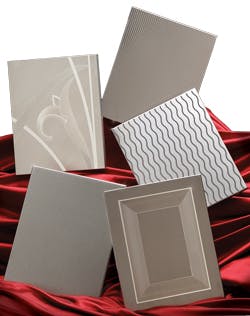Black-on-back film and precise laser energy helped solve edge problem
by David A. Belforte
Gary Geller is the owner and founder of Lasertron Inc., a company that has become one of the premier manufacturers of stainless steel cabinets and a pioneer in decorative architectural steel in the US. Housed in its own 19,000 sq. ft. facility in Sunrise, FL, Lasertron is on the cutting edge of technology, while constantly maintaining an environmentally green facility.
In 1980, Geller left Motorola, cashed in his retirement plan, put his house and everything else he owned as collateral for a bank loan to buy a laser, and started a contract laser job shop. He has had more than 25 lasers over the years and currently has six. Two of these lasers are fiber lasers. As a job shop, the company has cut stainless steel from 0.001 in. thick to 1.25 in. thick, ceramics, mild steel, copper, brass, nickel, silver, plastic, and various fibers. Their customers include aerospace and medical device companies, industrial equipment manufacturers, other job shops, and individuals.
The company's business has changed from primarily a laser job shop to a manufacturer of stainless steel cabinets and cabinet doors. Since the material used in the manufacturing of the cabinets is thin, brushed-finish stainless, Geller looked for a laser that was best suited for that application. He had at that time a 3 kw and a 6 kw CO2 laser. Both of these could do the job, but were expensive to operate. In 2009, Lasertron purchased a 1 kw fiber laser and replaced the 3 kw laser resonator, but kept the original workstation. The original samples they had made at the IPG applications lab looked good so they purchased the laser.
Challenge: variations in edge quality
When they started cutting their production material, they noticed variations in the edge quality and speed at which they were able toLaser Mechanisms, a maker of beam delivery devices, offered insight on this challenge. As a first step, they used a modified nozzle assembly to blow air around the nozzle to keep it cool. This improved the situation, but the results were still inferior to the lab samples. At the time, they noticed that PVC film with a black back gave better results than a white-backed film. Using the black-on-back film made things better, but still not good enough. After a bit of searching, they found a company that said they made a PVC film that would work with fiber lasers. They ordered a sample and found that it really did work well, and they have been using a product called Novacel for the last two years with good results. Recently, the company tested a sample of LaseRite Duo from American Biltrite, which also had good results.
Geller says that the only problem is that unless you have the capability to put the film on in-house, you will have a difficult time finding a steel service center that will supply it. Lasertron commits to purchasing a coil of steel at a time, which allows them to specify the type of PVC film that is applied. Since both of these films work with both fiber and CO2 lasers, it should be easy to convince the metal service centers to stock metal with this film. It would be helpful if those users of fiber lasers made their choice of films known to the service centers.
A natural fit
The fiber laser was a natural fit to cut the blanks for Lasertron's cabinets and cabinet doors. The ability to follow any contour allowed them to make a door with excellent accuracy and consistency, particularly in the corners where the fit and finish is critical. Long internal cuts are smooth and straight without the nibble marks characteristic of a punching process. Since all of Lasertron's cabinets and doors are made from stainless steel, having the blanks cut with the laser avoids the costly tool wear of the punching process.
Lasertron has developed an innovative and environmentally friendly process for making custom-etched stainless steel panels up to 48 × 96 in. Through an innovative process of selective masking, intricate designs of contrasting textures can be created on the surface of the steel. Simple or complex geometric designs, clip art, or photographs can be processed in this manner. Multiple masking allows shades of gray to provide the "wow factor" designers and their clients demand. The illusion of three-dimensional geometry can be created so people will look twice.
Since the material is stainless steel and no coatings or paints are used, there is never any fading, cracking, or peeling. The panels can be used indoors or outdoors without concern about temperature or humidity. Marine-grade stainless steel can also be used in those applications that are subjected to salt spray or corrosive environments.
As an added feature, the sheets can be custom cut to any shape and have the etched design perfectly oriented with respect to the contour of the cut shape, as well as the context of other panels.
The original bank loans from 1980 have long since been repaid, the retirement plan has been replenished. and the house has been traded in for a newer model. The original bank, however, went out of business. ✺
More Industrial Laser Solutions Current Issue Articles
More Industrial Laser Solutions Archives Issue Articles


